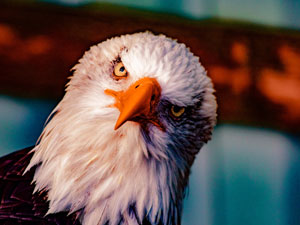
By Sarah Wilson, MA
To start with, it means eagles can see a wider range of colors than we can. We have three types of cones (photoreceptors) in our eyes; eagles have four. This allows them to detect ultraviolet light. If you’ve watched any crime dramas, you may know that many bodily fluids, such as blood and urine, can be detected by UV lights. Since fish, a main food of Bald Eagles, “go” as they go (they don’t have a urinary bladder to store urine in) and the same is true for some rodents, maybe an eagle to track a meal in this way. Also, UV light can detect injury to the body which makes me wonder if it is useful in spotting weakened prey?
Next, they can see a rabbit clearly at about 2 miles away. This makes perfect sense when you consider that eagles can soar at 10,000 feet (about 1.8 miles up). Their acute vision allows them to “cruise the grocery aisles” well above and completely out of sight of their target.
Additionally, eagles have two focus points (fovea) in their eye. We have one. One of their fovea is “deep” and the other “shallow.” The deep one may function as a sort of telephoto lens for the bird. When eagles look at things, they move their heads to view from different angles. This is thought to be them switching from one fovea to the other to get a better look.
And inside each foveae are packed about 1,000,000 cones per square millimeter, compared to our 200,000 in the same space. Since cones help with sharpness and contrast as well as color, just imagine what crisp detail an eagle must see!
So when we call someone “eagle-eyed” it’s quite the compliment.
Nature is amazing.
Interested in learning more about eagles?
Our local Audubon Center at Riverlands has Eagle Sundays January 8, 15, 22, 29, Feb 5. FMI: https://riverlands.audubon.org/events


